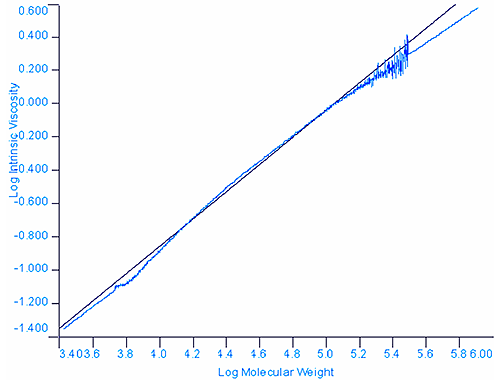Polythiophene is successfully characterized in THF at 45°C. The polymer precipitates at room temperature; therefore temperature control the sample vial, the columns, the detectors and the interdetector tubing - as provided by the TDA - is necessary.
Polythiophenes are conductive polymers with a backbone structure that consists of 5 member conjugated rings containing sulfur and polymerized at the 2 and 5 positions. The resulting material lends itself to varied uses in sensors, MEMS-based actuators, batteries, corrosion inhibition, EMI shielding, and electrochromic camouflage coatings. SEC/GPC analysis of polythiophene can be difficult because of potential chemical interactions with the GPC column. Additionally, the polymers may fluoresce depending on the exact nature of the substitutions on the polymer backbone.
A polythiophene sample was weighed into a vial and 10ml of THF was added to the vial. The vial was then capped and heated to 50 °C while stirring for 1 hour. The solution was then hot filtered into a 2 ml vial, which was placed in an autosampler tray controlled at a temperature of 45°C. The elevated temperature must be maintained because the polythiophene precipitates from solution at room temperature.
The pump and autosampler used was a Viscotek GPCMax equipped with the elevated temperature sample holder tray. The detector array was an integrated elevated temperature Viscotek Triple Detector Array (TDA) Model 302 equipped with an RI detector, a viscometer and a light scattering detector. For the measurements the TDA was set at a temperature of 45°C. The TDA held the columns and the interdetector tubing at a constant 45°C also. The columns used were two Viscotek I-MBHMW-3078 in series. The mobile phase was tetrahydrofuran (THF). The flow rate was set at 1 mL/min and the injection volume was 100µl.
The Viscotek I-Series columns were selected because of their superior inertness compared with standard SEC columns. These fluorinated columns are excellent for hard to elute polymers.

|
The sample solution was observed to be a 'fluorescent' orange color, therefore, preliminary measurements were made of the fluorescence at 670 nm, which is the wavelength of the diode laser employed in the light scattering detector. The fluorescence at this wavelength was found to be negligible. Good signal to noise ratios were observed on all detectors and no peak tailing was observed (Figure 1). The lack of tailing suggests that the sample is not being retained by the I-series columns. Results from duplicate injections of this sample are presented in Table 1. The RH is the hydrodynamic radius (weight-average) and IV is the whole polymer intrinsic viscosity. The dn/dc is measured from the integrated RI signal and the injected mass, knowing the sample concentration and injection volume. Molecular weights were calculated using the average dn/dc value measured of 0.24. The columns labeled M-H refer to the Mark-Houwink parameters which relate intrinsic viscosity and molecular weight according to the following empirical equation.
IV = [η] = K Ma
Taking the log of both sides,
Log (IV) = Log [η] = a Log M + Log K
A plot of the logarithm of the intrinsic viscosity versus the logarithm of the molecular weight yields a straight line of slope "a" and intercept of log K. See Figure 2. Flexible chain polymers yield "a" values in the range of 0.7. The "a" value of 0.83 found for this polythiophene indicates that it has a somewhat stiff chain.
| Inject | dn/dc (mL/g) | Mn (Da) | Mw (Da) | MZ (Da) | Mw/Mn | IV (dL/g) | RH (nm) | M-H a | M-H log K |
|---|---|---|---|---|---|---|---|---|---|
| 1 | 0.242 | 18,797 | 41,677 | 84,258 | 2.217 | 0.424 | 6.078 | 0.826 | -4.154 |
| 2 | 0.238 | 18,856 | 41,607 | 83,429 | 2.207 | 0.416 | 6.037 | 0.843 | -4.239 |
| Ave | 0.240 | 18,827 | 41,642 | 83,844 | 2.212 | 0.420 | 6.058 | 0.835 | -4.197 |

|
The polythiophene can be successfully characterized in THF at 45 °C using the I-series columns. The polymer will precipitate at room temperature; therefore temperature control of the sample vial, the columns, the detectors and the interdetector tubing is necessary. The TDA coupled with the GPCMax fulfills this need.